I have always been a Claussen Kosher Dill Pickle fan. Forever. I don’t like sweet pickles or bread and butter pickles, they just aren’t my thing. Claussen just tastes better, in my opinion, I don’t even like the shelf brand dill pickles. They are either too sweet or too tangy. That’s why I posted this Claussen pickle recipe several years ago.
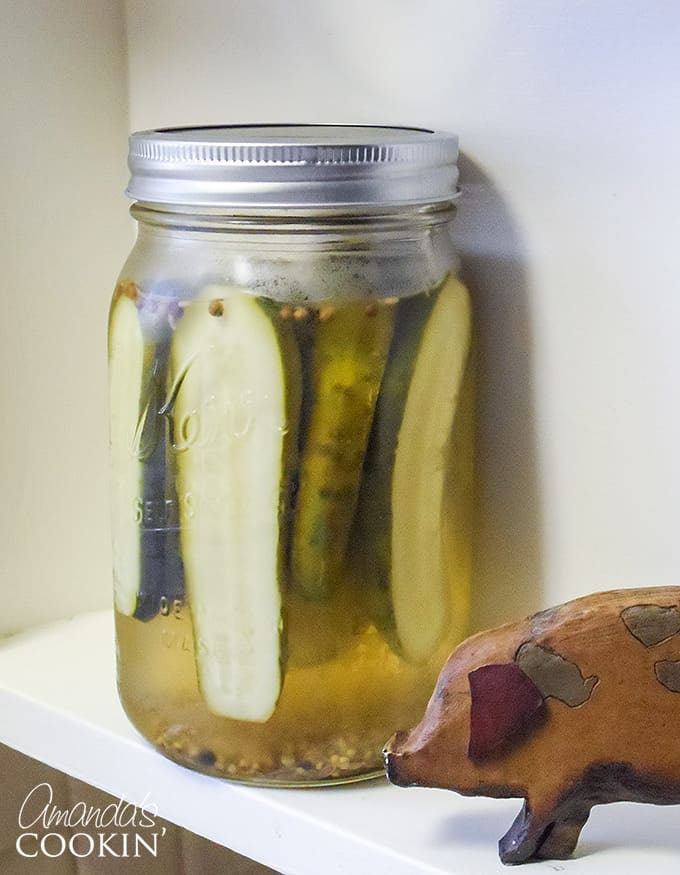
Refrigerator pickles are a lot easier to make because they don’t require using the traditional canning process. That also means they can’t be stored on a shelf in the basement or in the pantry, they must live in the refrigerator.
Recipe for Claussen Pickles at Home
Last year I made some pickles with the canning method and the recipe that I used had a very high vinegar to water ratio. So they were far too vinegary for me to eat straight from the jar, which is one of my favorite things, though they were great on burgers and in potato salad!
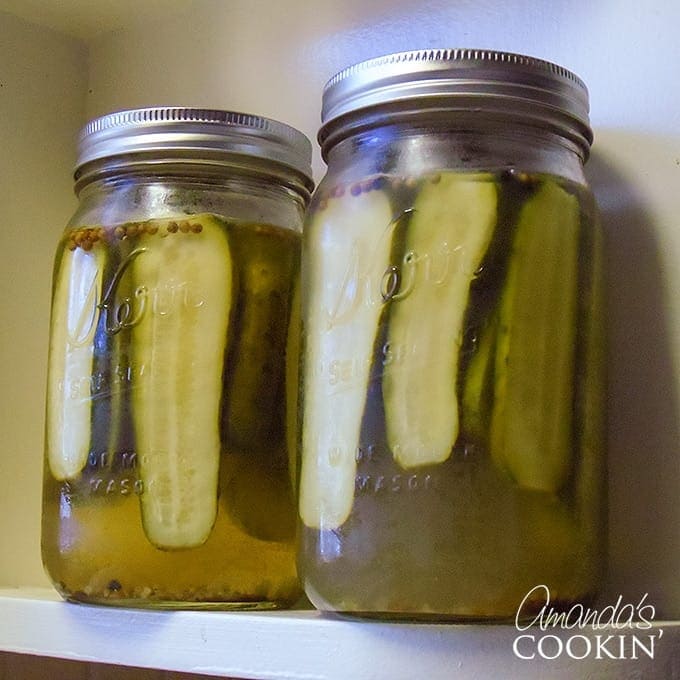
So I started my search for a Claussen copycat. I found this one but it used apple cider vinegar. I as concerned that would create a sweet pickle, which I don’t like, even though the author of that recipe is just like me. Yuk to sweet pickles!
So I looked at the actual Claussen ingredient label and it said they used distilled white vinegar. Some of the ingredients were different too, so I decided to use the recipe that I found as a jumping off point and created my own version.
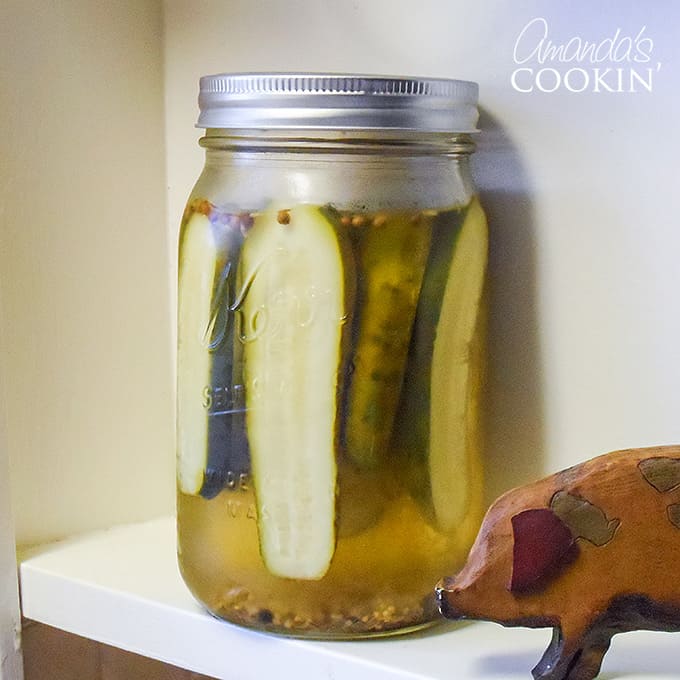
The verdict? Everyone in this house loves them! They aren’t exactly like Claussen, but pretty dang close! Close enough that they get devoured by everyone in this house.
They are actually fun for me to make. So while it would certainly be easier for me to grab a jar of Claussen from the grocery store, and I probably still will now and then, I love making my own.
My first batch was a bit cloudy, and they also had a distinctive mustard flavor. So I cut back the mustard seed in the second batch and I believe we now have a winner. :)
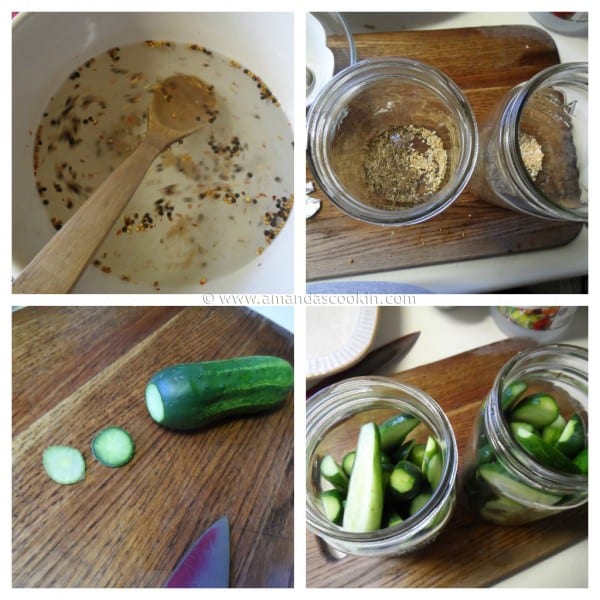
You’ll make the brine first, it’s easiest to do it in a 2-quart pitcher. You’ll see me mixing the brine in a bowl in the picture above. Don’t, it’s an extra step, just use a pitcher. Put the dill seed and dried garlic in the jars.
Now, make sure you give your pickling cucumbers a good rinse, make sure there’s no dirt. Trim the blossom end, I trim both ends, then cut in half lengthwise and distribute in your jars.
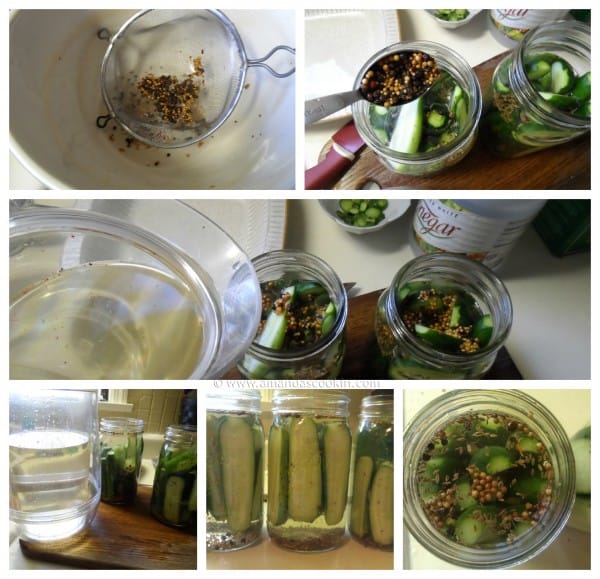
Before adding your brine, strain out the solids. Distribute the solids evenly among the two jars, then add brine. You will have leftover brine that can be discarded when you are all done.
When you perch the kid on your jars, you want air to be able to get in and gases to be able to escape.
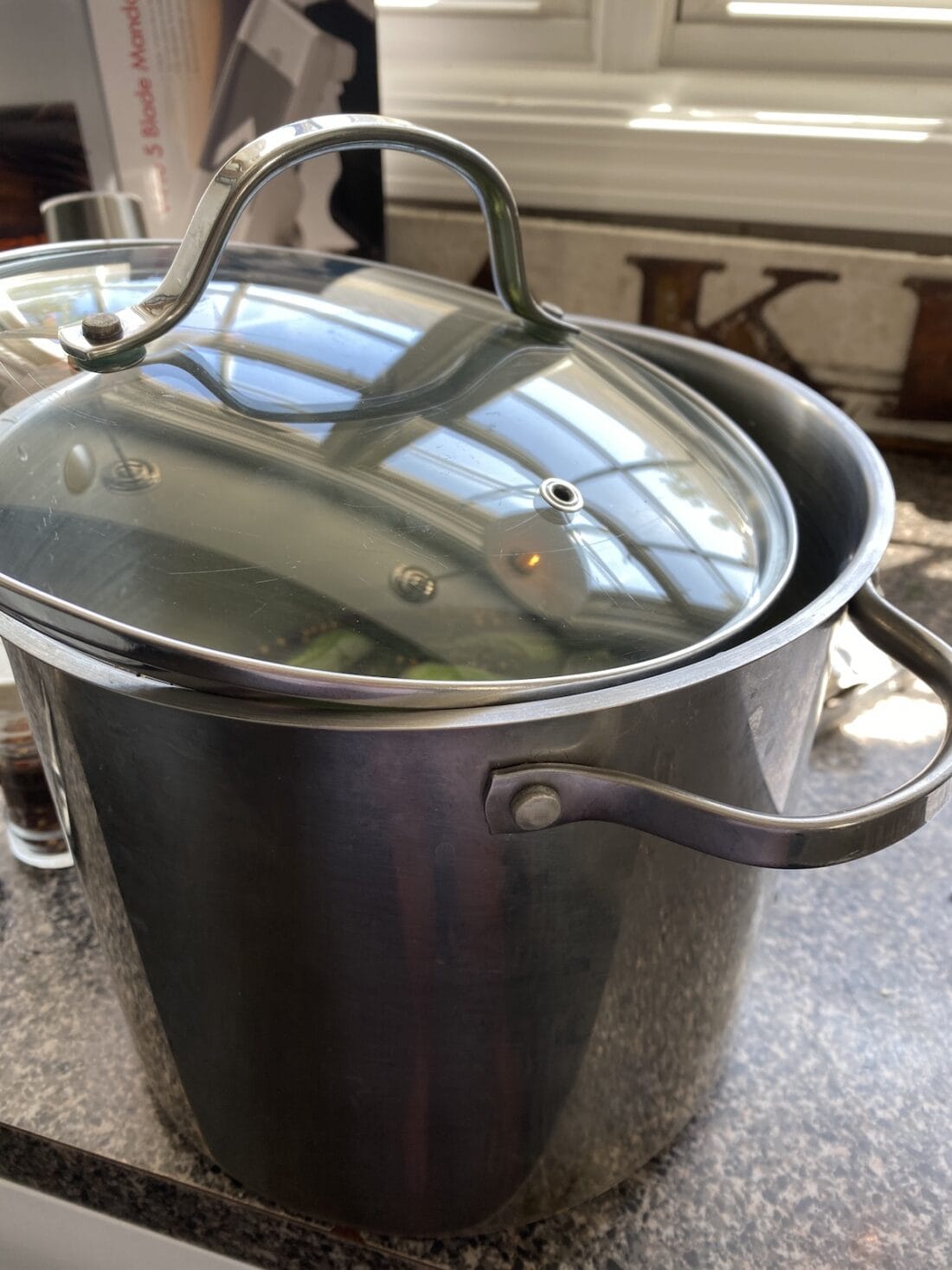
I actually put my pickles in one big pot now and then move them to a large covered glass container in the fridge instead of using jars now. Someone in the comments asked for a picture of perching the lid, you can see that above.
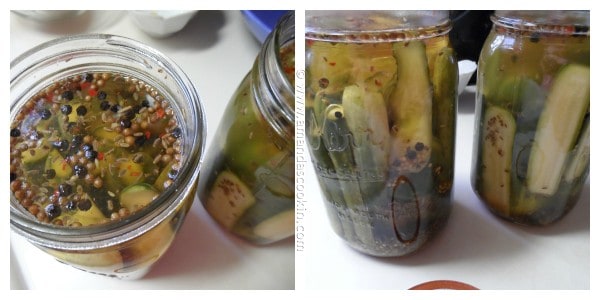
This is what they will look like after a day or so. They usually take 2-4 days. My first batch took the full four days while my second batch was ready in two and a half days. I think the difference was that I actually used three jars and they weren’t packed as tightly.
Enjoy – crunch!
Troubleshooting your pickles
Scum or film on top – During your first few days, fermentation takes place. You will probably see bubbles rising to the surface and may see some “scum” forming on the surface. Skim this off and discard. This is a completely normal step in the fermentation process.
White sediment at the bottom of the jar – According to Colorado State University, “A white sediment at the bottom of the jar may be caused by anti-caking agents in the salt or by the fermenting bacteria. Neither cause is harmful.”
According to Colorado State University “…factors that lead to spoilage include failure to remove blossom ends, failure to thoroughly wash products to be pickled, not removing the scum that accumulates on curing brines, using a weak brine or vinegar solution, not keeping the pickles covered with brine throughout the curing process, using deteriorated ingredients such as moldy garlic or decayed spices, or storing the pickles at too warm a temperature.”
You can download the complete PDF document from The Colorado State University here.
Important Tips to Note
The Blossom End
The blossom end of the cucumber (the end opposite from the stem) contains an enzyme that can make your pickles turn mushy. Always cut it off, I cut off both ends for good measure and to keep them uniform.
Vinegar
Use vinegar that has at least 5% acidity. Don’t reduce the vinegar in this recipe.
Salt
Only use pickling salt or coarse (NOT flaky) Kosher salt, though I always use pickling salt. Table salt contains an anti-caking agent that causes the brine to get cloudy. If you use table salt, it’s still safe, but you will have a cloudy jar of pickles with white sediment at the bottom.
Cucumber Types
Use cucumbers that are of the knobby variety, grown specifically for pickling. Check seed catalogs to find the different varieties. Cucumbers with a wax coating are not recommended as the brine will not be able to penetrate them. When selecting cucumbers, be sure that they are firm and not soft.
Wash Your Hands!
It’s tempting to reach in and turn your cucumbers, but please make sure you wash your hands first. Introducing any foreign oil or material from your skin could cause problems with your brine.
When your pickles are all gone, do you pour the pickle juice down the drain? Instead, try these ideas for reusing pickle juice! Looking for a unique recipe to try with your freshly make pickles? Here’s a Grilled Tomato Relish that’s great on burgers and dogs!
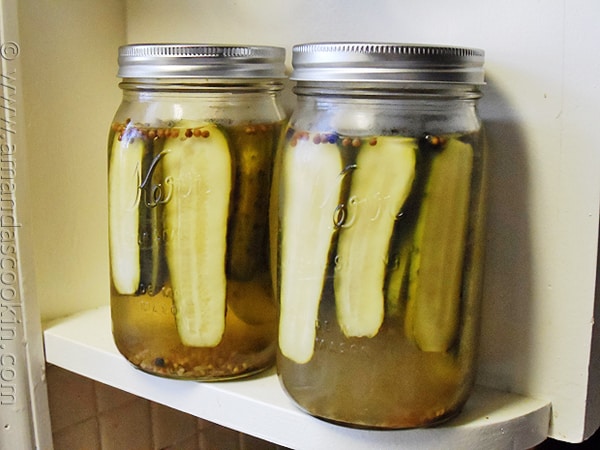
This Claussen pickle recipe was originally published here on September 18, 2012
More Related Recipes
- Cucumber Salad
- Sweet Corn and Chickpea Salad
- Grilled Corn and Zucchini Salad
- Pickled Beets
- Pickled Onions
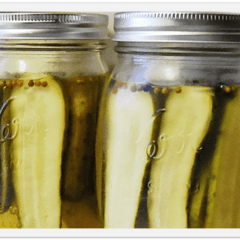
Homemade Claussen Pickles Copycat
IMPORTANT – There are often Frequently Asked Questions within the blog post that you may find helpful. Simply scroll back up to read them!
Print It Rate ItIngredients
- 20-25 small to medium pickling cucumbers
- 2 quarts cold water
- ½ cup white vinegar
- ⅓ cup canning/pickling salt or coarse Kosher salt
- 1 teaspoon coriander seed
- ½ teaspoon mustard seed
- ¼ teaspoon red pepper flakes
- 1 tablespoon black peppercorns
- 1 tablespoon dill seed
- ¼ teaspoon dried garlic
- Fine mesh colander
- 4- cup measuring cup
Instructions
- To make the brine, combine water and vinegar in a large pitcher. Add salt, coriander seed, mustard seed, red pepper flakes and black peppercorns. Stir until salt is dissolved. Set aside.
- Wash cucumbers in water and trim 1/8-inch off of the blossom end of each one. Slice each cucumber in half lengthwise.
- Divide the dill seed and dried garlic evenly between two clean quart sized jars. Fill jars with cucumber halves, fitting as many in as you can, they may be snug!
- Stir brine again to mix ingredients. Place a fine mesh colander over a large bowl or measuring cup. Pour brine through the colander, catching the brine solids in the colander. DO NOT discard!
- NOTE: You will not be able to fit all the water in this measuring cup or in the two jars. The goal here is to save the brine solids and use them, you will be discarding the left over vinegar and water mixture when finished.
- Once all the solids have been removed from the brine, distribute them evenly among the jars. Using the brine liquid in the measuring cup, pour into the jars until all the cucumbers are covered.
- Your brine level should cover your cucumbers and reach the bottom of the jar neck where the twisting begins. The cucumbers will also release some liquid as they brine, so don’t overfill the jar. Discard any remaining brine liquid.
- Cover lightly with a lid perched on top but DO NOT close and seal. Leave on the counter (out of direct sunlight) for 1 day, then move to the refrigerator for 2-3 more days, or until the cucumbers taste like pickles throughout.
- Secure lids on jars and refrigerate for up to six months.
Nutrition
Amanda Davis
Latest posts by Amanda Davis (see all)
- Cauliflower Pizza Crust - January 13, 2025
- Keto Peanut Butter Cookies - January 9, 2025
- Cloud Bread - January 6, 2025
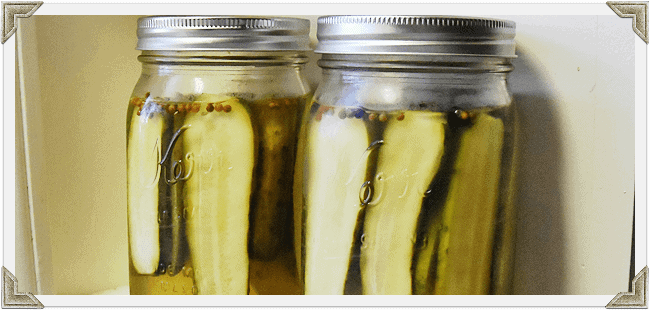
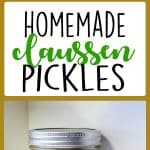
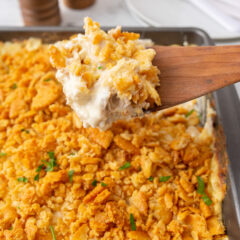
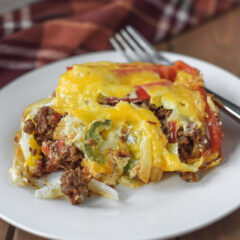
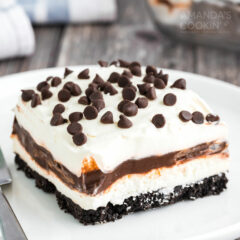
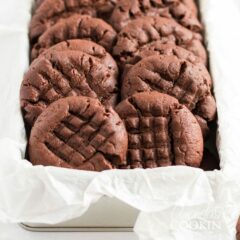





ginger peck says
How long do the pickles last in the fridge
Amanda Formaro says
Hi Ginger. As stated in the printable instructions, they can be stored in the fridge for up to six months. Enjoy!
Paul says
Arrrgh! I wish I had read this four hours ago. I did the recipe, saw the “fuzz”, thought it was mold and tossed the whole thing (sigh).
I was adventurous enough to taste one of the pickles on the end away from the foam and it was tasty.
Amanda Formaro says
Aww, I will update the post to reflect that, sorry about that Paul. Another thing I’ve discovered… in the directions it says to leave them on the counter away from sunlight. If any sunlight gets to them, the fuzz will grow and yes, eventually turn into mold and turn the pickle to complete mush. I made a batch of 3 jars last week and had to toss one out because of it. So I will be updating the instructions as well as making some more :)
Samantha says
I doubled the recipe but I tasted it after day one and it was very salty. Is that normal to be that way until day 4?
Amanda Formaro says
Hmm, I’ve never tasted them after day one so I’m not sure, but that could just be the vinegar talking. I actually have 3 jars setting up right now, mine are on day 4 today and should be perfect. Tasted one yesterday and they were almost done, there was still a cucumber after taste.
Samantha says
My fault, I think I measured wrong. I dumped the old brine out and replaced it with the correct measurement. It’s going to be awesome! Thank you so much for the recipe. I added a little sugar and more pepper flakes in a few jars just for kicks.
Amanda Formaro says
Oh I bet the spicy version will be delish!
Jenna says
I am now on to batch #2 of this recipe. TOTAL WIN! I will never pay for Claussen pickles again, which is good because my 3 boys will annihilate them some crunchy Claussens, and they actually now prefer this recipe you posted. Bonus – they’ll even clean, cut, make the brine and do them up all on their own, too.
Thank you. I believe I will be making this for the rest of my life, along with my boys, so on and so forth. <3
Amanda Formaro says
Thank you Jenna! I have a batch on the counter now that should be done today. Love these!
Len says
Amanda,
I am really into Claussen pickles also. They, at one time, had “SLICED” pickles which I prefer over halved or quartered. My question is; would sliced pickles work just as well?
Claussen now offers a “HOT AND SPICY” variety. Which I would also like to duplicate. So any suggestions on that one?
Thanks, Len
Amanda Formaro says
Hi Len! Don’t see any reason why sliced pickles wouldn’t work. They might not take as long on the counter. For hot and spicy, I would just increase the red pepper flakes in the recipe, and maybe even add in a little cayenne :)
terri says
It was fuzz. I have more pickling cucumbers so I am going to give it another shot in the morning. Did you boil the jars to seal them?
Amanda Formaro says
Hi Terri. No, you don’t want to boil them because you will lose the crunch. They are refrigerator pickles, so that seal you put on a jar for the shelf isn’t needed :)
terri says
Amanda,
We followed the recipe and when we went to close the jars there was white mold forming on top. Why would this be?
Amanda Formaro says
Hi Terri. Are you sure it was mold? Or could it have been foam? On the original recipe I followed it said this:
If at any point in the proceedings “fuzz” or “foam” develops on top of the brine, use a spoon to remove it. If there is “fuzz” attached to any of the cucumbers, remove the ones affected and be sure the others are still fully submerged.
TERRI says
WHAT SIZE MASON JARS?
Amanda Formaro says
Hi Terri. For this recipe it really doesn’t matter what size jars you use, as long as they are tall enough to hold the pickling cucumbers. The measurements are all done in a pitcher and then the juice is distributed amongst the jars. I believe mine were quart sized. :)
terri says
Thanks so much! Can’t wait to start pickling! My husband did a batch with a different recipe the other week and I was not impressed! Ready to win the pickling war with your recipe! Thanks for sharing!!!!
Amanda Formaro says
Would love to hear how they turn out!
Spencer says
I currently have 3 batches in the fridge and all have been tweaked and are compared to an open jar of the real deal Claussen. Mine are really close but not exactly in flavor (I’ll have to try the coriander seeds). I use fresh dill and garlic. I also throw in a few allspice berries and fennel seeds as both are in the Claussen jar if you dissect the spices at the bottom of the jar. I think there’s probably a secret ingredient that they don’t list on the ingredients label. I’m making mine one jar at a time so my quantities are way smaller than yours but close to the amount that Claussen uses in 1 jar. Also, to get them really really crispy and crunchy, ice bath them overnight before you slice them up and they absorb the water and really get crunchy. Good luck.
Amanda says
Great idea on the ice bath!
Ted says
I also make dill pickles, but I use a hot brine. To make them crunchy, my recipe also calls for soaking the cukes overnight in an ice bath.
Alison says
I made these pickles a few days ago and the flavor is spot on. The only thing missing is the signature crunch. Did yours come out crunchy? Also, why is it that we leave out the pickles loosely capped and then refrigerate? Thanks!
Amanda says
Mine did come out crunchy, but not as crunchy as Claussen :) You leave the lid off to allow gases to escape during the marination process.
Ron says
Try topping the solution with two grape leaves or use Pickle Crisp® Granules from ball canning. Both give great results for that super snap/crunch.
Bob says
Have you tried this recipe with green tomatoes in place of cucs? I have almost 20 lbs of green tomatoes after finishing my end of summer garden clean up.
Amanda says
No I haven’t, but that’s an interesting idea. I wonder how those would be? I have the same “problem” here, lots of green tomatoes ripening on the counter!
Sue b. says
This recipe made me sing! “Ohhh, how I love pickles! Ohhh, I could make pickles! These sound like great pickles! Thanks for the re-ci-pe! AAA-mann-da!”
Amanda says
Thanks Sue! I haven’t bought a jar of pickles since discovering this. But I wonder if I’ll be able to find pickling cucumbers at the store come winter :-/ Probably not.
Katherine says
I made pickles during the winter. I didn’t use pickling cucumbers, but they work just as well. They sell mini cucumbers at grocery stores all year round
Charlie says
We have the pickling cucumbers here year round. I found them at Meijers. I don’t know if you have Meijer stores in your area or not but if you do they have them. We also have a large international grocery store called Saraga’s that I think will have them too although I haven’t looked, Might be a problem in small towns.
Diane Stecik says
I want to try these but I am wondering what
is considered, dry garlic. I have never
seen or heard of this. What do you use?
Amanda Formaro says
Hi Diane! It’s often called “minced garlic” and is found with the dried herbs and spiced. It’s basically dehydrated garlic. Here’s an example on Amazon http://amzn.to/UzELXn
Kathy says
Can you make these pickles without slicing them and leaving them whole instead?
Amanda Formaro says
Hi Kathy. Yes, though I haven’t made them this way myself. I am not sure if it would take longer for the brine to penetrate the pickles, but my guess would be a resounding yes. So I would say that you would need to store these in the refrigerator for quite a while longer for them to be done.
Leah says
What an awesome recipe! LOVE these pickles and now I love that I can make them at home! YES! : )
Amanda says
Hope you like them, we love them here!
Diane {Created by Diane} says
oh these look great, my mouth is watering I can just about TASTE them!
Brenda @ a farmgirl's dabbles says
Homemade pickles are the bomb! These sound great!
Jen (Balancing Beauty and Bedlam) says
We LOVE pickles in this home, and I think I could even manage making them homemade. :) YUM!
Suzanne says
I’m headed to the store to get some cukes right now! Gotta have these!
Suzanne says
Headed out to the store to get cukes now!
Sherri says
I make an excellent claussen pickle. Its basically the same but you MUST use fresh garlic and fresh dill. I don’t use the coriander but will give that a try. Enjoy your pickles.
karen miller says
if you use fresh dill and garlic how much of each should you use?
Amanda Formaro says
To substitute fresh garlic for the dried, use double the amount. So for 1/2 teaspoon of dried garlic, you would use 1 teaspoon fresh garlic. one commenter suggests using 4 heads of fresh dill per jar.
Suzanne says
OMG! I can’t WAIT to make these. Going to the store tomorrow for the cukes!
Russ Feller says
Failure for me…after two weeks in frig they looked very moldy to me, so much so I couldn’t risk eating them. What a waste
Amanda Formaro says
I’m sorry they didn’t turn out Russ. This has been a successful recipe for me and for many who post comments here. But some people have had trouble with it too. I’m sure there are a lot of factors involved, but what caused the problem is hard to tell. I am sorry that they didn’t work out for you!
josh says
You should skim off the moldy scum, it is part of the fermentation process. I threw mine out 12 jars too the first time!
Bill Holtby says
I did two batches.. First batch I was trying to double the brine and doubled the Vinegar, salt and spices but forgot to double the water. Turned out a little too salty but still good.. Second batch tasted great on the counter on the third day they turned cloudy and then got mushy in the fridge.. Not exactly sure why.. Well cleaned, removed both ends and used new and sterilized jars… Searching the web I found several possibles..
Great first effort and will figure out what went wrong..
http://nchfp.uga.edu/how/can_06/pickleproblems.html
Todd Lawrence says
use this recipe – or any of the other “claussen clones” – use 50/50 White and Cider Vinegar – theey will come out awesome!